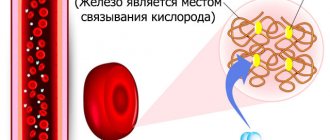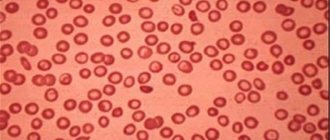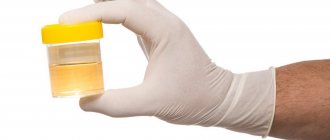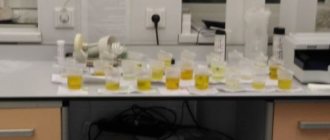Every person's blood contains red cells. In medicine they are called red blood cells. Often, when they penetrate into another biological fluid (urine), hematuria is diagnosed. But at the same time, it is necessary to take into account the quantity, and also understand whether they are accurate.
If red blood cells in the urine are elevated, the reasons in men may lie in age-related changes in the body. Normally, if a representative of the stronger sex is from 18 to 45 years old, there should be a number of them, calculated by the formula (4.2-5.6 * 10)12 per liter of blood. At the same time, the indicator should not lean upward. Up to these age limits, a deviation of 0.2 is permissible.
What are blood cells responsible for and how to find out their level
Red blood cells are specific blood cells that primarily respond to areas of inflammation and infection. From a biological point of view, their role in the body is invaluable. They ensure the delivery of oxygen to various organs, tissues, muscles, and also, as a reverse function, transport carbon dioxide to the lungs. In this way, breathing and nutrition of the body are carried out.
Initially, red blood cells, like other blood cells, are formed in the bone marrow, and then they begin to actively participate in the hematopoietic system. Their average period of activity is 4 months, and then cell breakdown occurs in the liver and spleen. Red blood cells cleanse the body of toxins and other harmful substances that can cause intoxication, so they cleanse the blood in a specific way. In the presence of inflammatory processes and diseases, the concentration of cells begins to increase sharply. This can be observed in urine tests, blood tests, swabs from the throat, nose, urogenital tract, etc.
Erythrocyturia is detected where inflammation or infection is localized. An increased level of red blood cells in a woman’s urine indicates a pathology of the urogenital tract, which requires further treatment. Checking the presence and number of red blood cells in a woman’s urine is not difficult at all. It is also inexpensive in terms of financial costs. To do this, you need to do the following laboratory tests:
- general urine analysis;
- analysis according to Nechiporenko.
If a patient needs to find out the general level of these cells in the body, then a clinical blood test is best suited for this, which accurately calculates their concentration together with erythrocyte indices. However, there is no direct connection between the level of red blood cells in the blood and urine, so it is necessary to conduct a full examination of the organs of the urogenital tract. What are red blood cells in a woman’s urine? According to the reference values of many laboratories, red blood cells should be absent in a woman’s urine or their level should be no more than 3 in the field of view (p/zr), everything else is not the norm.
What types of red blood cells are found in urine?
Sediment microscopy is the main method for detecting increased levels of red blood cells in urine.
Every mid-level medical worker in the clinical department of the laboratory of a medical institution knows the method.
Under a microscope, red blood cells look like rounded formations with the middle pulled inward. In size, they occupy an intermediate position between large leukocyte cells and small platelets. Appearance and shape depend on hemoglobin saturation. This substance forms the basis of the volume of red blood cells.
It is customary to distinguish 2 types of cells:
- unchanged - have a typical structure, do not differ from blood cells, are colored red;
- altered - formed during a long process of leaching in the urine, as a result of which hemoglobin disappears, the cells shrink or take on the appearance of rings.
The leaching process does not always depend on pathology. It is possible in the absence of substances containing alkalis in food products. These include:
- nuts;
- vegetables;
- buckwheat.
If a person also sharply limits salt, the alkaline reserve is lost. To maintain acid-base balance, the body “extracts” the necessary substances from its own cells.
That is why, in order to draw the correct conclusion from the analysis report, it is necessary to ask the patient about dietary preferences. Some people try to treat themselves with fad diets. The consequences lead to impaired metabolism.
What is considered a deviation from the norm?
An increased number of red blood cells in the urine indicates blood, which is why doctors use the term “hematuria.” In terms of severity it can be:
- minimal (microhematuria) - urine appears to be of a normal straw-yellow color, does not contain impurities, only under a microscope a specialist counts the number of red blood cells in the field of view, which exceeds the normal number (for an adult this is 1 in the urine in men, 3 in women, for children up to a year from 2 to 4 cells), in the conclusion the phrase “single in the field of view” is often written;
- macrohematuria - there are so many red blood cells that they cover the entire field of vision, usually when the number of cells is 100 or more, the color of the urine changes, it becomes red-brown.
The color of urine changes not only depending on the number of red blood cells in the urine. Redness is caused by eating beetroot dishes, abuse of tablets containing Aspirin and Analgin, and during treatment with vitamin B12 injections.
When is microhematuria considered physiological?
Microhematuria is not always associated with pathological changes. This means that under certain conditions it becomes possible for red blood cells to pass through restrictive barriers. Moderately elevated red blood cells in the urine are found:
- after taking a significant dose of alcohol;
- when digestion is overloaded with spicy and salty foods;
- due to overheating in the sun, during “sunstroke”;
- after going to the steam bath;
- against the backdrop of physical training and hard work;
- as a result of stressful situations.
Excess ultraviolet radiation promotes the penetration of red blood cells into the urine
Doctors always warn about the rules for collecting urine for analysis. These include all the listed reasons for restrictions. If the patient did not comply with the conditions, then the resulting conclusion greatly complicates the interpretation of violations. There is a reason for repeated research.
Rules for submitting material for research
Collecting urine for analysis requires adherence to the following principles:
- water procedures of the genitals before collecting material;
- using clean containers (special containers are sold in pharmacies);
- compliance with the deadlines and restrictions set by the doctor (there are several methods, for example, when only the first urine should be given, only the middle one, or only after 10 hours without urinating);
- You should tell your doctor about sexually transmitted infections, urethral problems, injuries, or other known causes that may cause blood to enter your urine.
If the study is urgent and the woman is menstruating, urine can be collected through a catheter. In other cases, taking the test during this period of the cycle leads to false positive results.
What causes a pathological increase in red blood cells in the urine?
An increase in red blood cells in itself is not a diagnosis. The patient must be examined to identify possible pathology. Based on the origin of hematuria, three possible causes can be distinguished:
- renal or renal - talk about pathological changes in the kidneys;
- prerenal (somatic) - indicate various diseases not directly related to the urinary organs;
- postrenal - means that a large number of red blood cells enter the urine from the ureters, bladder, and urethra.
The reasons for the increase in red blood cells in the urine may be determined by the gender and age of the person due to the characteristic anatomical and physiological features.
Drug-induced hematuria
Taking some pharmacological drugs can lead to bleeding of internal organs. Red blood cells in a urine test in higher numbers than normal may mean that taking medications has a negative effect on the body.
Most often, this condition is caused by the following groups of medications:
- anticoagulants;
- phosphamides;
- pentoxifyllines;
- cyclophosphamides.
An excess of vitamin C can lead to increased levels in urine.
What changes in the kidneys lead to hematuria?
Renal causes are caused by diseases and injuries of the kidneys, affecting the glomerular and tubular apparatus, interstitial tissue.
What does blood in urine mean in men?
The most common pathologies accompanied by hematuria at different stages include:
- trauma (rupture of the renal capsule due to a bruise, penetrating knife wound) - the localization of internal bleeding is determined by the high content of red blood cells in the urine;
- inflammatory diseases of the kidneys (glomerulonephritis, pyelonephritis, kidney tuberculosis) – contribute to impaired filtration and the passage of red blood cells through the membrane of the glomerular apparatus, increase blood flow to the site of inflammation, involve the walls of capillaries in the pathological process;
- stone in the pelvis or calyces - the proliferation of crystalline structures leads to injury to the mucous membrane and feeding vessels;
- malignant kidney tumors - as the tumor grows, the vascular walls are destroyed by malignant cells, hematuria is moderate, unchanged red blood cells appear in the urine;
- hydronephrosis - leads to overstretching of the kidney capsule, the outflow of urine is difficult, at the same time venous stagnation occurs, conditions are created when red blood cells under increased pressure pass through the wall of the vessels and enter the urine.
When diagnosing renal damage, special attention should be paid to high levels of protein, leukocytes, and nitrogenous substances in the blood. These indicators indicate the form and stage of inflammation.
What are somatic causes?
Somatic (non-renal) diseases involve the urinary system in the pathological process through various mechanisms. Similar examples could be:
- blood diseases that impair coagulation (hemophilia, thrombocytopenia) - unusual red blood cells gain the ability to penetrate the basement membrane of the glomeruli of the renal apparatus;
- severe intoxication - under the influence of toxins, decay products, toxic substances, increased membrane permeability occurs, red blood cells freely pass into the urine, observed in any febrile conditions, hemorrhagic fever, snake bite;
- hypertension - in severe cases it affects all blood vessels, including the kidneys;
- heart failure - leads to venous stagnation of blood in the inferior vena cava system, spreading to the renal vein;
- uncontrolled use of certain medications, their negative properties can be equated to toxic effects, these include anticoagulants, sulfonamides, large doses of vitamin C.
Red blood cells exit the vessel cavity through the damaged wall
Diet
For various diseases of the kidneys and urinary tract, it is necessary to adhere to a special diet. Its task is to reduce the load on the excretory system and prevent irritation of the mucous membranes. The diet should be followed if abnormalities are detected in urine analysis, at least until an accurate diagnosis is made.
Meals should be fractional. It is necessary to reduce the caloric content of the diet and the proportion of animal protein. Caution is required when choosing vegetables and fruits. It is undesirable to eat foods rich in organic acids and purine bases. List of restrictions:
- fried, fatty, salted, smoked;
- lard, poultry, pork, lamb meat;
- fatty fish;
- smoked meats, marinades, canned food;
- broths (meat, fish, legumes, mushroom);
- sweets, chocolate;
- onion garlic;
- spices;
- turnips, radishes, eggplants;
- sorrel, spinach, parsley;
- citrus.
The diet should be dominated by products of plant origin (including oils), dairy and fermented milk products, and all types of cereals. Eggs are allowed. On the recommendation of a doctor, salt should be completely eliminated or a little added to prepared dishes before consumption. It is important to adhere to the drinking regime. The daily amount of liquid should not be less than a liter. Sample menu for the day:
- Breakfast. Buckwheat porridge, steamed chicken cutlet, Chinese cabbage, cucumber and dill salad with butter. Toast from salt-free bread with jam or honey. Herbal tea or rosehip decoction.
- Snack. Apple baked with cottage cheese and peanut butter.
- Dinner. Vegetarian cabbage soup, mashed potatoes, boiled fish, beet and carrot salad. Tea or compote.
- Snack. Cottage cheese with berries.
- Dinner. Steam omelet from 1-2 eggs or wheat porridge, vinaigrette with fresh cucumber without beans.
- Late dinner. Kefir or jelly.
Postrenal pathology with hematuria
Any damage to the urinary tract below the kidneys is considered postrenal. An increased content of red blood cells accompanies pathology of the ureters, bladder, and urethra.
In severe forms of cystitis with ulcerative-necrotic, gangrenous, hemorrhagic lesions of the bladder wall, red blood cells appear as the supplying vessels are destroyed. The movement of a stone along the ureter or its location in the bladder sharply injures the walls and contributes to the appearance of fresh red blood cells in the urine.
In cases of damage to the bladder during cystoscopy, catheterization, and therapeutic instillations, moderate hematuria is possible for several days after the procedure. A cancerous tumor located in the bladder causes gross hematuria due to the destruction of a large vascular zone. The patient notices an increase in blood secretion at the end of urination.
Oxalate stones are the most dangerous in the development of gross hematuria
Associated symptoms
If bloody urine appears, consult a urologist immediately. A description of the accompanying manifestations of hematuria will help to establish an accurate diagnosis, for example, such as: weakness, dizziness, severe thirst, pain in the right side, lower back and lower abdomen, unpleasant pain during or immediately after urination, the appearance of cloudy sediment or sand, visible with the naked eye, and small stones, frequent urge and inability to empty the bladder.
The patient’s age is also important, since certain life stages are characterized by certain diseases. Cancer patients may experience paroxysmal urethrorrhagia, which has nothing to do with hematuria.
Features of the causes of hematuria in men and women
In men, red blood cells in the urine increase:
- with prostatitis - inflammation of the prostate gland contributes to loosening the walls of nearby vessels, red blood cells from them penetrate into the urine through the urethral canal;
- adenoma and prostate cancer - destroy blood vessels.
Female gynecological diseases with uterine bleeding are accompanied by blood entering the urine from the vagina during the act of urination. Most often, bleeding is accompanied by:
- uterine tumors;
- cervical erosion.
Women are not recommended to collect urine for analysis during menstruation and for several days after. If absolutely necessary, urine can only be collected with a catheter.
Read about hematuria during pregnancy in this article.
When identifying hematuria in a teenager, in addition to common causes with adults, it is necessary to take into account the possibility of:
- congenital vascular anomalies;
- diathesis suffered in childhood;
- consequences of a viral infection;
- hypersensitivity to drugs.
A child at any age needs to be examined to determine the cause of hematuria.
The purpose and essence of the three-glass test
Localization of the focus that caused the presence of blood cells (increased levels of red blood cells in the urine), establishing what this means and the causes of erythrocytosis allows a 3-cup sample.
The essence of the method is to simultaneously collect 3 glasses of urine from one bladder emptying.
OAM containers are urinated into and numbered. The containers are tightly closed with a lid and stored in a cool place until submitted to the laboratory.
The results of the study show what type of hematuria is present:
- Initial - determines signs of urethritis, blood bodies are present in the first glass.
- Total - bleeding occurred in the upper urinary sections, red blood cells in 1, 2, 3 containers.
- Terminal - blood is detected in 2 portions, this indicates pathology of the bladder.
Portion No. 3 is not given to women; it is studied for the diagnosis of prostate diseases in men. In the weaker sex, urethritis is detected when blood is detected in the first glass, cystitis if blood is found in the 2nd glass. The content of red blood cells in 1 and 2 glasses indicates inflammation of the kidney tissue - pyelonephritis.
Erythrocyturia in pregnant women and after childbirth
An increased number of red blood cells in the urine of pregnant women is also not the norm. The reasons for this condition lie in the pathologies described above, but do not forget that while carrying a child, the body begins to function differently. What do red blood cells in urine mean in pregnant women?
The growing fetus puts pressure on the bladder, uterus, and ureters, so congestion and vascular disorders in the genitourinary area begin. This is a favorable environment for the development of bacteria, but for a healthy body without chronic pathologies this will not be a problem. There may be a slight increase in indicators (microhematuria), which does not cause discomfort. However, severe erythrocyturia requires treatment and emergency medical measures.
Chronic diseases of the genitourinary system during pregnancy in a woman can worsen, as indicated by increased indicators. Most often these are kidney diseases (pyelonephritis) that require treatment. In this case, the pregnant woman is sent to the hospital, where, if possible, she undergoes the following procedures:
- “positional treatment” to restore urine outflow;
- ureteral catheterization;
- puncture nephrostomy in severe cases (drainage of urine using a catheter);
- kidney decapsulation (removal of the affected area of the kidney);
- removal of the kidney in the most severe cases.
In case of advanced renal pathologies, the pregnancy has to be terminated, so it is necessary to immediately consult a doctor and not start the inflammatory process.
Often, during gestation, urolithiasis (sand, stones) occurs, but in this case the treatment will be simply therapeutic, which includes increased water consumption. After childbirth, high levels of red blood cells in the urine of women are also a pathology, as this indicates inflammatory changes in the urogenital tract. Changing hormonal levels have no effect on red blood cells, so ideally they should not increase under any circumstances.
Symptoms
Typically, erythrocyturia is rarely asymptomatic, and women immediately notice pathological changes in themselves. Symptoms can be very different depending on where the inflammatory process is localized and in which organ. The color of the urine begins to change. If with slight erythrocyturia (microhematuria) this may not be noticed, then with a pronounced increase blood appears.
In some cases, the urine takes on a very dark shade, which should alert the patient. All this requires finding out the reasons, but usually everything is accompanied by the following symptoms:
- pain in the lower abdomen;
- frequent urination;
- pain during or after urination;
- fever, general malaise; weakness, headache;
- pain in the back or sides;
- "renal colic";
- lack of appetite or nausea;
- increased blood pressure;
- blood in the urine (gross hematuria);
- bloody discharge from the vagina.
Minor erythrocyturia may be asymptomatic, but this is usually due to improper collection of biomaterial, so special attention should be paid to this issue. Such nuances can greatly distort the results of the study, since tests must be taken in a sterile container and only after a thorough toilet of the genitals. Only a doctor can determine the final cause of the disease by prescribing additional examinations. As a rule, these indicators increase together with protein and leukocytes, which accurately indicates the infectious nature of the disease; therefore, in no case should symptoms that appear be ignored.
How to diagnose hematuria
The initial step in diagnosing hematuria is a general blood test. To carry it out, several simple conditions must be taken that will ensure maximum reliability of the analysis results with the lowest percentage of error:
- A few days before the analysis, it is worth limiting your diet, namely, not eating food that contains aggressive pigments that can change the color of the biomaterial;
- Before the analysis, be sure to carry out hygiene procedures for the genital organs of men and women.
- A sample of the biomaterial is taken in the morning, and the first portion of urine is poured into the toilet, and the second is collected in a specially prepared sterile container;
- To carry out the analysis, fresh samples must be available, so make sure to bring the sample to the laboratory no later than two hours from the moment the material is collected.
In the laboratory, to identify the cause of hematuria when examining a sample of biomaterial, a three-glass sample method is used: the sample is divided equally into three containers. The result is determined by the degree of pigmentation:
- if the most saturated scarlet color is in the first test, this means that the patient has urogenital problems;
- if the deepest scarlet color is in the last test, then the patient has bladder dysfunction;
- the same shades in all three samples indicate possible problems with the urinary system, and therefore with the kidneys.
If the test for red blood cells is positive, several clarifying studies are carried out, such as a general blood test, a biochemical blood test, ultrasound of the kidneys and bladder, ultrasound of the prostate for men and fallopian tubes with ovaries for women.
If the above methods do not confirm the presence of the disease, they resort to the method of biopsy and contrast x-ray.
Which doctor should I contact?
The cause of erythrocyturia is successfully eliminated using modern medicine, but clinical manifestations must be noticed in time. The following specialists traditionally deal with urinary tract diseases: urologist; nephrologist; gynecologist. These doctors can be contacted both in public and private medical organizations. A urologist deals exclusively with genitourinary pathologies, and a nephrologist specializes only in kidney diseases and related dysfunctions.
A gynecologist ideally treats diseases of the pelvic and genitourinary organs, since in women everything is interconnected. Often gynecological diseases and sexually transmitted infections cause inflammation of the urinary tract, but in this case treatment becomes more difficult. The patient has to be observed by several specialists who use different approaches to treatment. Some private clinics have a doctor such as a urogynecologist who deals with similar problems, so it is best to find such a specialist in order to avoid progression of the disease and improper therapy.
If erythrocyturia is detected in the analysis, the doctor pays attention to other indicators and symptoms of the patient.
An increase in protein and red blood cells often indicates a renal origin of the pathology, and a normal increase in cells and the presence of salts means urolithiasis. In most cases, further examination is required, which includes the following diagnostic measures:
- urine analysis according to Nechiporenko, where leukocytes, red blood cells and casts are counted as accurately as possible; urine culture for microflora with sensitivity to antibiotics;
- ultrasound of the bladder, ureters and kidneys, where you can visually see stones, tumors and foci of inflammation; repeated OAM;
- blood biochemistry (urea, creatinine, free nitrogen, uric acid) to diagnose renal failure;
- cystoscopy and biopsy in severe cases (instrumental examination of the urethra and bladder walls);
- pelvic ultrasound and colposcopy; radiography of the kidneys;
- MRI or CT scan of the urinary tract.
This is an extensive list of studies that is necessary to establish the cause of erythrocyturia. Initially, everything depends on the patient’s condition and her symptoms, so the doctor will not always prescribe a long list of diagnostic procedures.
A general analysis (microscopy) can only show the fact of an increase in red blood cells in the urine, but practically does not help determine the specific causes. More research should be done to find out what this means and get more accurate results. One of the options for what to do when an increased indicator is detected is the three-glass test method. Its principle is to collect urine during one urination into different containers:
- the first jet - into one container;
- the next few - to the second;
- and, finally, the last one - to the third.
If a urine test shows too many red blood cells in the first portion, problems with the urethra are the cause. If there are excesses in the average sample, the patient most likely has a bladder disease. Too high an indicator in each serving indicates diseases of the ureters or kidneys.
Diagnostics and necessary tests
Diagnosing the presence of blood in the urine is not difficult, but in order to establish the cause of the appearance, it is necessary to take appropriate tests and undergo an examination.
First of all, it is necessary to distinguish between true hematuria and false hematuria - urine staining red for physiological reasons. In this case, microscopic examination determines the absence of red blood cells.
To detect microhematuria in a visually unchanged urine sample, you can use special test strips that will indicate an increase in the level of red blood cells. The advantage of this method is the speed of obtaining indicators, but the disadvantage is the impossibility of accurately determining the amount of blood. The result is defined as negative, weakly positive or positive.
To confirm the clinical diagnosis and assess kidney function, the following is prescribed:
- general urine analysis, which allows you to determine quantitative indicators of the content of red blood cells, leukocytes, bacteria, mucus, salts, various specific cells,
- a three-glass sample, which is used to determine the level of damage,
- urine analysis according to Nechiporenko and Zimnitsky,
- clinical blood test to determine blood reaction and possible inflammatory process,
- ultrasound examination of the kidneys and pelvic organs,
- men undergo prostate ultrasound,
- excretory urography.
If urography does not visually reveal any changes, and episodes of gross hematuria recur, the patient is advised to undergo voiding cystourethrography and cystoscopy.
In the diagnosis of neoplasms, tuberculosis and internal inflammatory processes, CT or MRI of the abdominal cavity and pelvic organs is important. In addition, a piece of the organ can be removed for biopsy.
Why is this condition dangerous?
The danger is not the increased indicators themselves, but the pathological process that caused their increase. In this case, you need to find out what initially provoked erythrocyturia. Without treatment, various complications and more serious pathologies are possible. For example, kidney diseases (pyelonephritis, glomerulonephritis, nephritis) can transform into chronic illnesses or kidney failure.
Urolithiasis has a tendency to relapse and further develop, since sand, without proper removal, begins to transform into large stones, causing serious consequences. Untreated cystitis, in turn, can constantly recur, significantly reducing the quality of life, so it is necessary to begin medication measures as quickly as possible.
The most terrible complication is a malignant tumor in the genitourinary organs, which begins to progress.
Blood in the urine appears constantly, as well as other symptoms, which are not helped by various antibiotics and painkillers. In this case, surgery and chemotherapy are required.
We can say that the danger of erythrocyturia is expressed in the development of the following diseases:
- chronic pathologies of the urinary tract (cystitis, pyelonephritis, glomerulonephritis, etc.);
- renal failure;
- increase in stones in the urinary tract;
- malignant/benign tumor, cyst of the urinary tract or pelvic organs;
- persistent arterial hypertension;
- nephrotic syndrome;
- functional pathologies of the bladder and kidneys.
In any case, a full examination and consultation with a doctor is necessary, who will prescribe competent treatment and prevent the development of complications, so it is absolutely impossible to delay going to the doctor.
Treatment
Hematuria is not a disease, but a symptom that does not need to be treated. It is necessary to find out what caused the appearance of cellular elements in the urine and, if necessary, eliminate it - cure inflammation, get rid of kidney stones or chronic intoxication. If hematuria appears, it is important to consult a doctor as soon as possible and undergo additional research methods, based on the results of which treatment is prescribed. Before making a diagnosis and starting therapy, it is recommended to limit the consumption of table salt and foods high in salt, avoid drinking alcohol, spicy and fried foods, do not overwork and avoid overwork.
Regardless of the reasons for the increase in red blood cells in the urine, this symptom should not go unnoticed. Although in some cases, especially if there is non-compliance with the feminine hygiene test, it is advisable to conduct repeated studies to clarify the data. If red blood cells are again elevated during a repeated urine test, an ultrasound examination of the kidneys and bladder, an x-ray of the urinary tract and a number of other studies are required to clarify the diagnosis and prescribe effective therapy.
The causes of symptoms should be treated only on the basis of a doctor’s conclusion drawn up based on the results of a comprehensive examination. Early detection of the problem and prescribed treatment can prevent more serious complications.
Primary treatment strategy
Examinations prescribed if red blood cells are detected in the TAM, each of which can confirm or exclude a specific disease:
- Prostate-specific antigen: detection of prostate cancer in men.
- Red blood cell test (sickle cell): sickle cell anemia.
- Computed tomography: presence of tumors, cysts, foreign bodies.
- Ultrasound: presence of urolithiasis, neoplasms, ureteral obstruction.
- Urethroscopy will show the movement of stones and the presence of tumors.
- Cystoscopy confirms the development of inflammatory processes, tumors and stones.
- A prostate biopsy is done to determine whether the cells have become cancerous.
- Selective angiography will tell you about vascular abnormalities.
- A kidney biopsy diagnoses glomerulonephritis and tumors.
The data obtained during the examination determines the root of the problem, allowing the correct treatment to be prescribed. If the cause of hematuria is the presence of foreign bodies, then the patient is admitted to the surgery department.
Small volumes of the body allow it to be removed without delay. Large sizes require serious surgical intervention. Fibromas, papillomas and cysts are also surgically eliminated.
Detection of cancer requires referral of the patient to the oncology department. Specialists provide conservative treatment or chemotherapy, and advanced cases require surgical intervention.
Inflammatory processes are eliminated by combination therapy: tablets, injections, electrophoresis. In case of hematuria caused by the movement of stones, the location of the stone is determined, then the question of how to remove it is considered. The method of crushing or dissolving is used for this.
Large stones are removed surgically.
How to lower your red blood cell count
It is necessary to immediately diagnose and identify the disease that provoked the presence of red blood cells in the urine. Then, based on the examination data, the following treatment methods are applied:
- antibiotic therapy;
- when urine stagnates, diuretics are prescribed;
- diet therapy;
- treatment with anti-inflammatory drugs;
- reducing fluid intake to relieve the kidneys;
- If urolithiasis, cancer or organ injury is detected, they resort to surgical interventions.
You should know that staining of urine can be caused not only by the presence of red blood cells in it, but also by an increase in hemoglobin.
Basic methods for eliminating symptoms
Hematuria requires the following therapeutic procedures:
- Depending on the disease that caused the bleeding, medications are used to relieve pain, usually Ketorol.
- In case of significant blood loss, hemostatic medications are used: Dicynon, Vikasol.
- The presence of stones in the urethra or ureter requires therapy with antispasmodics (No-spa) to facilitate their removal. If a positive effect is not achieved, then the problem with stones is solved surgically.
- The presence of hematuria and proteinuria requires treatment with corticosteroids (hormonal drugs).
- Pathology that has become chronic requires taking B vitamins and preparations containing iron.
- Inflammatory processes are stopped with antibiotics.
- Before choosing an antibiotic, a sensitivity test is done. This makes it possible to determine exactly the type of medication that is capable of destroying the pathogenic flora that caused inflammation.
Widespread:
- Gentamicin. The drug shows its effectiveness in the fight against intestinal bacteria, as well as gram-positive and gram-negative microorganisms. Gentamicin is quickly absorbed into the bloodstream, the maximum therapeutic effect is achieved within 1 hour. The effect of the drug is designed for 8-12 hours.
- Fluoroquinols. Ciprofloxacin is widely used in the treatment of kidney diseases. Available for oral and parenteral use. The components of the drug are easily absorbed into the intestinal walls, from where they enter the tissues and fluids of the body. Not recommended for use by children under 14 years of age, expectant mothers or breastfeeding women.
Detection of red blood cells in the urine means that a repeat OAM is required. This is not always caused by the presence of pathology.
Only if the results remain unchanged, and the detection of red blood cells in the repeatedly donated biological fluid requires a thorough examination in order to identify the disease that caused hematuria.
Diet
Diet plays an important role in the treatment of urological and nephrotic diseases. The patient is not recommended to abuse hot, spicy, fried foods, or drink alcoholic beverages. Drinking plenty of fluids (at least 2-2.5 liters per day) is necessary for any inflammatory process of the urinary tract. You will also have to give up smoking, as it increases the risk of developing cancer and other urological pathologies.
A special diet is necessary if you have urolithiasis. The correct diet is selected based on what types of salt crystals are detected in the TAM. These can be phosphates, oxalates and urates. If you have phosphates (phosphaturia), you should avoid some fried foods (fish), dairy products, eggs, and liver. Detection of oxalate salts (oxalaturia, ammonium salts) requires avoidance of foods rich in vitamin C.
First of all, you should not eat the following foods:
- citrus fruits, apples;
- broths;
- cocoa, chocolate;
- greens, salads, sorrel;
- ascorbic acid;
- tomatoes;
- beet;
- nuts;
- berries;
- beans and beans.
Detection of urate salts (uraturia) requires a complete restriction of deli meats, broths, as well as coffee, chocolate, hot and spicy foods. For any urolithiasis, it is necessary to drink fluids intensively, as this helps remove crystals and stones from the body. In this case, various herbal preparations are also useful (rose hips, moraine tincture, birch buds, calendula), which dissolve sand and calculi of the urinary tract.
With a proper and balanced diet, erythrocyturia should disappear, as well as accompanying symptoms and diseases.
What not to do
First of all, it is necessary to understand that self-medication is in any case unacceptable, and you should consult a doctor at the first symptoms of pathology. During pregnancy, you should not hesitate and start the disease, as this can lead to fetal death and even organ loss. If erythrocyturia is detected, it is strictly not recommended to carry out the following actions: Taking antibiotics and other medications on your own, especially during pregnancy. Deliberately start the disease and not consult a doctor. Abuse alcohol, smoking, as well as spicy and fatty foods.
Donate biomaterial for research during menstruation. Do not adhere to the prescribed diet. Limit fluid intake. Resist the urge to urinate for a long time. Any patient needs to follow the doctor’s instructions, as this will help quickly restore the health of the genitourinary area. In many cases, it is necessary to retake the analysis in compliance with the rules for collecting biomaterial, because in other cases this significantly distorts the results and misleads the doctor. Herbal infusions and herbal preparations can be taken independently, but they also have contraindications and side effects, so a visit to the doctor is an urgent need.
It must be said that significant erythrocyturia is a very dangerous condition that requires careful diagnosis. The cause of its appearance can be a wide range of diseases, so it is especially important to correctly diagnose and prescribe treatment. Red blood cells are immediately activated in the presence of pathology in the genitourinary area. Most often, this is an alarming diagnostic sign that cannot be ignored.
Detection of red blood cells in urine should not be missed even without patient complaints. The possibility of a hidden course of the disease should be taken into account. When a doctor prescribes repeated tests, it is necessary to take the preparation and collection of the analysis seriously. Any violations of the rules lead to unreliable information and make diagnosis difficult.
How to lower your red blood cell count
It is necessary to immediately diagnose and identify the disease that provoked the presence of red blood cells in the urine.
Then, based on the examination data, the following treatment methods are applied:
- antibiotic therapy;
- when urine stagnates, diuretics are prescribed;
- diet therapy;
- treatment with anti-inflammatory drugs;
- reducing fluid intake to relieve the kidneys;
- If urolithiasis, cancer or organ injury is detected, they resort to surgical interventions.
You should know that staining of urine can be caused not only by the presence of red blood cells in it, but also by an increase in hemoglobin.










